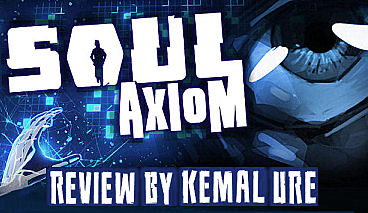
Soul Axiom Review
A very interesting setup with a solid atmosphere and an amazing soundtrack is marred by weak puzzles, poor voice-overs, and design flaws.




Genre: Adventure
Release date: February 29, 2016
I was initially drawn to Soul Axiom due to its curious premise; imagine a future where mankind has finally conquered death by creating a digital “afterlife”. When people die, their souls are transferred to a computer simulation named Elysia, where they can re-live their favorite moments forever. I think this setting provides amazing potential for some creative storytelling and puzzle design. Unfortunately, it’s difficult to say that the developer Wales Interactive was able to fully realize the game’s potential. Soul Axiom gets many things right, but at the same time it does so many things wrong. It’s been awhile since I played a game that left me with this level of mixed feelings.
Soul Axiom tells a convoluted story that involves multiple characters, a nonlinear narrative and a healthy dose of plot twists. This is certainly most welcome. Although confusing at first, the game slowly unfolds each character’s stories and motives, and in the end it finishes with a satisfactory finale that answers most of the open questions. The initial phases of the story require a little bit of patience; a lot of information is thrown at you without sufficient explanation. However, you soon get to know more about the characters and start connecting the pieces.
It’s interesting to note that the game is actually not about the protagonist himself/herself. You’re more like an observer in Elysia where you visit other people’s memories. Later you realize that those people have played key roles in the development of Elysia itself. The bulk of the gameplay involves opening portals to memories that represent a specific moment from that person’s life. You solve puzzles in those memories to learn more about that person, and after the successful completion of the sequence, you’re rewarded with a cutscene that reveals an important point of the story. These individual memories are very diverse within themselves. You visit all kinds of places, from everyday locations (an apartment, hospital, university etc.) to more extraordinary places (an abandoned space station, Aztec temple etc.). I feel this aspect of the game is similar to that of an older game: Faust: Seven Games of The Soul. Anyone who’s played that game will understand what I mean.
Speaking of other games, it’s safe to say that Soul Axiom shows its influences very openly. The visuals of the Elysia locations are very reminiscent of the Tron franchise. That actually bugged me a little bit. It’s totally normal to be influenced by another artist, but the similarities between Soul Axiom’s and Tron’s graphical styles border on making them appear exactly the same. I would’ve expected more effort from the developers in that department.
Another glaring similarity to other games is the focus on the protagonist’s hands. Most of the puzzles in the game require you to manipulate the environment using special powers such as telekinesis, and each power is symbolized with different hand gestures and animations. It’s difficult to explain this similarity with words, but if you’ve played Bioshock Infinite, the use of hands in this game will immediately remind you of that game. Not to mention that both games have a giant flying creature as the antagonist.
Returning to the storytelling, although the game offers a complex story, it chooses an ineffective narrative style. Apart from the cutscenes, you need to read a lot of documents found in the game in order to get a full grasp of the story. A fair share of these documents are found in optional areas; if you miss them, it’s easy to get confused.
Even the cutscenes aren’t very effective, mostly due to low-quality voice-overs and dialogue. The dialogue is poorly written and the voice-overs sound forced most of the time. I remember reading another review in which the reviewer complained about not being able form a bond with the characters. I believe this isn’t due to how the characters are written, but mostly due to the poor voice-overs.
I would classify most of the puzzles in the game as easy/trivial. Unfortunately, most aren’t very interesting either. It’s usually very obvious which hand/power you need to use in order to get through a particular obstacle. There are also some easy logic puzzles, and they are nicely integrated into the particular memory in which you are playing.
Putting too many easy puzzles in a game presents a problem when the game is a long one, as is Soul Axiom. I would say an average adventure game with a decent length would last 7-8 hours (without taking hints of course); Soul Axiom took me around 18 hours to finish. If the game actually had complex and interesting puzzles, that wouldn’t be a problem at all. On the contrary, I’m a big fan of longer games. However, solving easy puzzle after easy puzzle for a long time just makes the overall experience boring. I think the game would have been much better off with shorter gameplay.
Not all the puzzles in Soul Axiom are trivial, but the more difficult ones aren’t really difficult, as they’re well-designed. When you’re stuck, most of the time it’s because the clues aren’t clear or require some obscure thinking. On top of that, some puzzles involve action sequences, which can be very frustrating for hardcore adventure players. In particular, there’s one near the end which requires precise timing of your telekinesis skills. I spent like an hour on that puzzle, and it was almost a game-breaker for me. I really don’t see the point of inserting such a sequence into the game when the player is so close to the finish line. In addition, the game isn’t very sensitive to your mouse inputs during the action sequences, which makes these sequences even more difficult than they should be.
What really disappoints me is that the designers are actually capable of designing good puzzles! There are a couple of places where the puzzle design really shines. For instance, a sequence that involves time-traveling is simply brilliant. The puzzles in the haunted mansion sequence are also well-executed. I was sad to see that the quality of the puzzles in those chapters was not reflected in the rest of the game.
I was genuinely surprised with the quality of the soundtrack. It seems to me that nowadays even the big studios are not putting a lot of effort into music in their games. Soul Axiom however, despite being an indie title, comes with an amazing soundtrack full of memorable tunes. I frequently found myself humming through the pieces while playing the game, and believe me, I cannot remember any other game in which the same thing has happened. Every piece fits the individual chapter seamlessly; for instance, you get tribal chants when you’re wandering in the jungle and haunting electronic music inside Elysia. With the help of the soundtrack, Soul Axiom does a very good job of creating a surreal and creepy atmosphere.
Before wrapping up, I want to mention two more issues that affected my game-playing experience. In most places, the graphics are very dark. I tried tweaking the brightness settings, but it didn’t help. I missed a couple of clues and wasn’t even able to navigate in some places. Another issue is the save-game system. When you enter a memory you need to solve it completely; if you quit in the middle of the sequence, all progress is lost. I won’t even attempt to discuss why this is a bad design decision.
Despite all the issues, I actually enjoyed playing Soul Axiom. It has a very interesting setup, a solid atmosphere and an amazing soundtrack. I was really sad to see that the game wasted a lot of potential with weak puzzles and design flaws. I’m hoping that the developers will take those issues into account and we’ll get a better game next time, as they are clearly capable of doing this.
|
+ Creepy and surreal atmosphere
+ Awesome soundtrack
+ Solid plot
+ Diverse set of locations
– Weak dialogue and voice-overs
– Mostly very easy puzzles – Absurd save-game system
– Graphics are too dark in some places
|

|
Processor: Core i3 / AMD A6.2.4Ghz
Memory: 2 GB RAM
Graphics: NVIDIA GeForce GTX 260 / AMD Radeon HD 5750. OpenGL 3.3
Hard Drive: 5 GB available space
Processor: Core i3 2.4Ghz
Memory: 2 GB RAM
Graphics: NVIDIA GeForce GTX 260 / AMD Radeon HD 5750. OpenGL 3.3

Leave a Reply